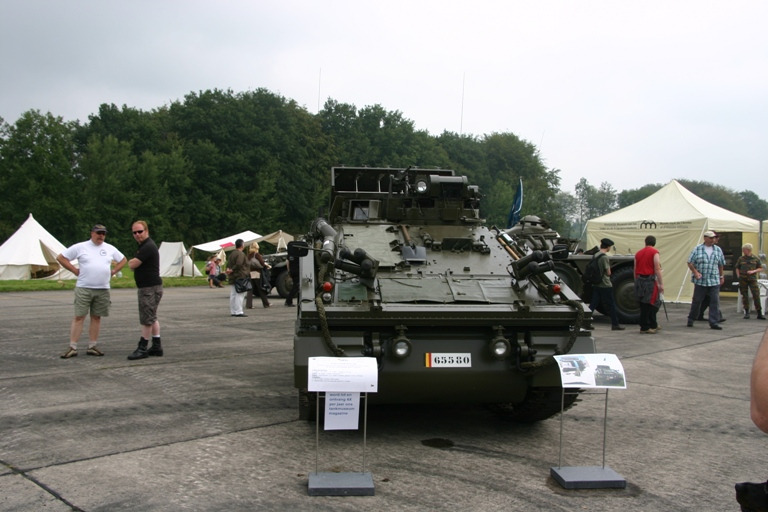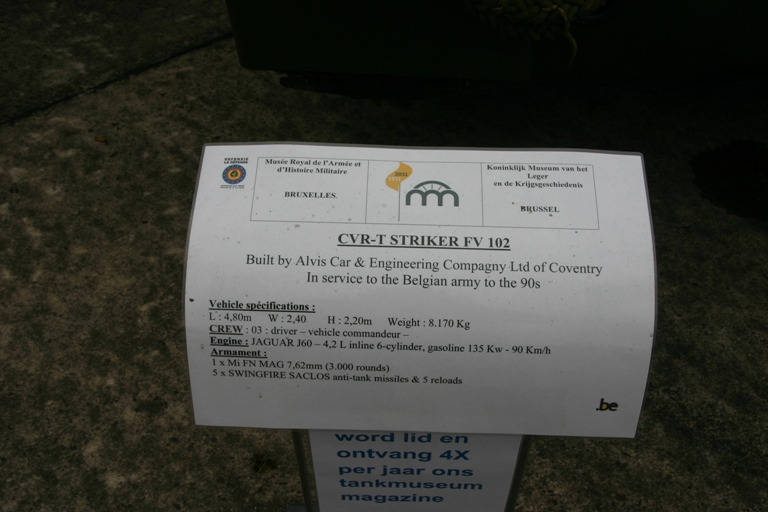- Yes
- No
- (independent) BeNeLux tree
- France: BeNeLux subtree
- Britain: BeNeLux subtree
- Belgium (sub) tree
- I said ‘no’ in the previous poll
- other

History
History
Development
The FV102 Striker was developed in the United Kingdom as part of the Combat Vehicle Reconnaissance (Tracked) (CVR(T)) family by Alvis in the 1960s. It was designed as an anti-tank guided missile carrier, armed with the Swingfire wire-guided missile system. The Striker entered British Army service in 1976, but Belgium also adopted the CVR(T) family, ordering a total of 701 vehicles across various variants starting in 1975, including 43 Strikers. Deliveries to the Belgian Army began in June 1976. The Belgian procurement was part of a broader effort to modernize its armored reconnaissance capabilities during the Cold War, equipping units with lightweight, highly mobile vehicles suitable for NATO’s forward defense strategy in Western Europe.
The Striker was powered by a Jaguar J60 4.2-litre petrol engine producing 135 kW (180 hp), capable of reaching speeds up to 80 km/h. In later years, a few British and export vehicles were upgraded with diesel engines, but Belgian Strikers retained their original petrol configuration throughout their service life.
In Belgian service, it was integrated into the COMRECCE (Commandement de Reconnaissance) structure alongside other CVR(T) types like Scorpion and Scimitar.
Training and Operations
In January 1978, Belgian troops from the 2de Jagers te Paard and 4de Chasseurs à Cheval underwent training on the Striker and Swingfire system at the Salisbury Plain in the UK, under British instruction. This included live-fire exercises and familiarization with the missile’s wire-guided system. The training emphasized the Striker’s role in reconnaissance battalions to counter superior enemy tank forces, with the ability to engage targets at up to 4,000 meters while remaining concealed. The missile’s thrust vector control allowed for unique maneuvers, such as 90-degree turns post-launch.
During the Cold War, the Strikers were primarily deployed with the Belgian Forces in Germany (BSD/FBA) as part of the I Belgian Corps, stationed in West Germany to deter potential Warsaw Pact aggression. Under the COMRECCE, which served as a covering force for the corps, the vehicles were assigned to reconnaissance battalions. Specifically, the 1e Jagers te Paard (1 JP), stationed at Bad Arolsen, and the 4e Chasseurs à Cheval (4 ChCh), stationed at Arnsberg, each operated Strikers in their A, B, C, and D Eskadrons (squadrons). Each squadron was structured as a Panzeraufklärungskompanie (armored reconnaissance company) equipped with 6 × Scimitar, 6 × Scorpion, 3 × Striker, and 3 × Spartan vehicles. This setup allowed for mixed reconnaissance troops combining scouting, fire support, and anti-tank capabilities.
Beyond the Cold War posture, the Belgian Army used its CVR(T) vehicles, including the Striker, on UN deployments in the Balkans (such as in Bosnia and Kosovo during the 1990s) and Somalia (as part of UNOSOM in the early 1990s). In these operations, the Striker provided long-range anti-tank firepower in light reconnaissance roles, supporting peacekeeping and stabilization efforts in challenging terrains. The vehicles proved versatile in urban and rural environments, though their light armor limited them to hit-and-run tactics against heavier threats.
The Belgian Strikers were fully phased out by 2004 as missile technologies advanced and the army transitioned to newer systems like the Pandur and Piranha platforms. Some vehicles were restored and preserved, with examples like the one with unit number “080” displayed at the Tankmuseum in Kapellen, restored by volunteers. This vehicle was part of a platoon including other CVR(T) variants, highlighting its integration into Belgian armored reconnaissance.
Differences between the British and Belgian Striker
Differences
The Belgian variant of the FV102 Striker was largely similar to the British model but had a few notable differences. Most significantly, Belgian Strikers retained the original Jaguar J60 4.2-litre inline 6-cylinder petrol engine, rather than later diesel conversions used elsewhere. This gave it slightly higher acceleration and a top speed of 80 km/h on road.
In terms of armament, Belgian vehicles used the FN MAG 7.62 mm machine gun (3,000 rounds) as the secondary weapon, in place of the British L7 GPMG. Additionally, they were equipped with two 71 mm Lyran flare mortars for illumination and signaling, a feature specific to Belgian service.
Other than these distinctions, the layout, missile system, and armor protection remained consistent with the standard Striker design.
Specifications
Length: 4.8 m
Width: 2.4 m
Height: 2.2 mWeight: 8.1 tonnes
Engine: Jaguar J60 – 4.2 L inline 6-cylinder gasoline engine, 135 kW (180 hp)
Speed (on road): 80 km/h
Range: 756 kmCrew: 3 (commander, driver, missile operator)
Armour:
Front Sides Rear Roof 25 mm 12.7 mm 12.7 mm 12.7 mm
Armament 5 × Swingfire ATGM (ready to fire) + 5 reloads Missile details Wire-guided SACLOS, 150–4,000 m range, 7 kg HEAT warhead (800 mm RHA penetration), 185 m/s speed Secondary armament 1 × FN MAG 7.62 mm (3,000 rounds); 2 × 71 mm Lyran flare mortars (Belgian variant) Smoke system Multi-barrel smoke grenade dischargers Guidance Manual/Semi-automatic command to line of sight Suspension Torsion bar Missile System
The Swingfire missile uses thrust vector control for maneuverability, allowing launches from concealed positions. It can be controlled remotely up to 100 m from the vehicle.
Place in War Thunder
This ATGM carrier would serve as a mobile anti-tank option in reconnaissance lineups, providing long-range firepower with good mobility. Its light armor makes it suitable for flanking and ambush tactics at mid-to-high BRs.
Regarding nations
Britain
As the original developer, the Striker is already in the British tree, but the Belgian variant with additional flare mortars could be a premium or event vehicle.
BeNeLux
With the BeNeLux subtree announced for France in the “Seek & Destroy” update, this Belgian Striker fits perfectly as a dedicated anti-tank vehicle. An independent BeNeLux tree is also viable given the shared history and numerous unique vehicles from Belgium, Netherlands, and Luxembourg. The nations have cooperated economically and militarily, including joint defense initiatives. For more, see: BeNeLux (Belgium, Netherlands & Luxembourg) Ground Forces.
The Striker would be a key ATGM platform in any BeNeLux or Belgian-focused tree.
Pictures
On display and in training
Sources
Sources
- VOX Militair Weekblad, Issue 6, 9 February 1978: “Swingfire en Striker te Salisbury”
- http://www.legerdienst.be/Tankmuseum.html
- https://en.wikipedia.org/wiki/FV102_Striker
- https://en.wikipedia.org/wiki/Combat_Vehicle_Reconnaissance_(Tracked)
- https://en.wikipedia.org/wiki/Swingfire
- Army Guide: FV102 Striker SP
- Trackpad Publishing: CVR(T) Part 1 and 2 (Belgian variants)
- BSD/FBA 89: Gliederung und Stationierung der belgischen Streitkräfte in Deutschland im Jahre 1989
- Belgian & Luxembourg TO&Es 1980–1989 v2.3
- Laurent (2017, November 17). CVRT – Striker/Swingfire – 1973–2003. Armée Belge Belgisch Leger. https://www.abbl.be/1973/04/03/cvrt-strikerswinfire-1973-2003/
- Gunfire Museum with the War Heritage Institute (Belgium), Trackpad - Belgian CVR(T) Family, Part 2 (Model Foto Focus Series).







